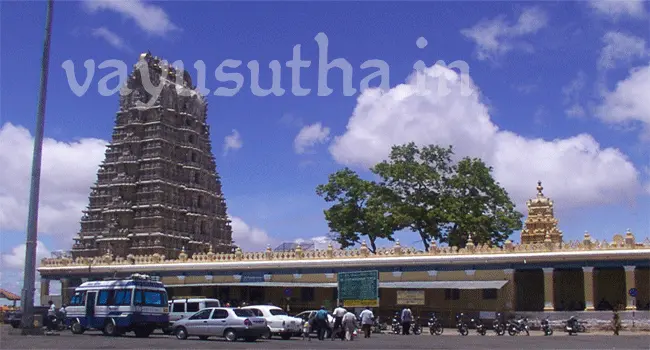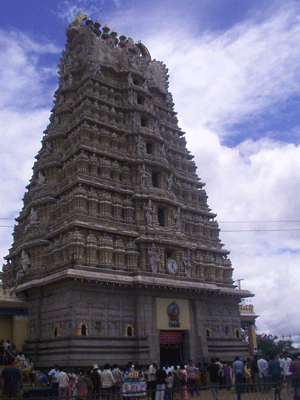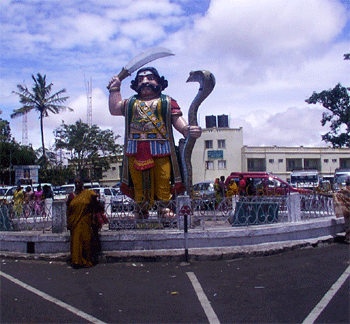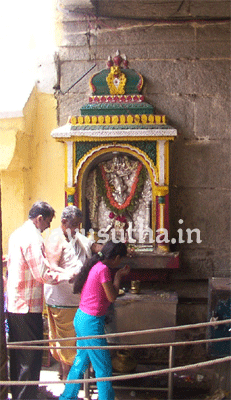
Mysore-Mysuru
 The place known popularly as ‘Mysore’ is officially renamed Mysuru. This is the third largest city in the state of Karnataka. It was the capital of the erstwhile Mysore State. It is located in the foothills of the Chamundi Hills about hundred fifty kilometers southwest of the present state capital Bangalore. The city is more popularly known for its cultural activities and is celebrated as the cultural capital of the State.
The place known popularly as ‘Mysore’ is officially renamed Mysuru. This is the third largest city in the state of Karnataka. It was the capital of the erstwhile Mysore State. It is located in the foothills of the Chamundi Hills about hundred fifty kilometers southwest of the present state capital Bangalore. The city is more popularly known for its cultural activities and is celebrated as the cultural capital of the State.
The name Mysore is the corrupt form of ‘Mahishuru’. This place was once ruled by the demon Mahishasura. Maa Sri Chamundeshwari whose abode is Chamundi Hills slays the demon and brings him under Her feet. Since this place was ruled by Mahishasura it is called ‘Mahishapura’, later it became ‘Mahisuru’. Even now Royal family of Mysore uses the name ‘Mahisuru’.
It is interesting to note that the abode of Maa Sri Chamundeshwari is called ‘Chamundi Hills’ and the city called ‘Mahisuru’ is at the foot of Chamundi Hills.
Wodeyars of Mysuru
The Wodeyar dynasty was founded as a feudatory principality in 1399, which grew into the Kingdom of Mysore. The Wodeyars ruled that kingdom almost uninterruptedly between 1399 and 1947; they ruled initially as representatives of the Vijayanagara Empire (1399–1565), then as independent rulers (1565–1761), then as puppet rulers under Hyder Ali and Tipu Sultan (1761–1796) and finally as allies of the British crown (1799–1947). The Wodeyars of Mysore are the only Indian Royal family in the 5000-year history of India to have ruled a kingdom for more than 500 years.
Chamundi and Chamundi hill
Chamundi Hill is about thirteen kilometers from Mysuru. Atop Chamundi Hills, the famous Sri Chamundeswari Temple is located. ‘Chamundi’ or ‘Durga’ is the fierce form of ‘Shakti’. She is the slayer of demons, ‘Chanda’ and ‘Munda’ and also ‘Mahishasura’, the buffalo-headed demon.
She is the kula devatha [patron deity] of the Mysore Maharajas and the presiding deity of Mysore. For several centuries they have held the Goddess Chamundeshwari, in great reverence.
Kula Devatha and other Deities of Mysuru
For Mysuru Wodeyars Maa Chamundeswari is the kula devatha – family deity. As is the practice of the Vijayanagara Samrajya Sri Hanuman is the protection or a guardian deity of the territory. Even before Wodeyars came here the locals were worshiping Sri Ganesha as the deity who removes all obstructions. Therefore it is no wonder that all these three deities had gained importance in worship during the rule of Wodeyars.
Sri Chamundeswari Temple at Hills
 Chamundi Hills which is about 3500 feet MSl is the abode of Sri Chamundeswari. The hill and the temple look glories from Mysuru and make a picture-perfect scene. The spectacular scene is that the temple is the jewel of the hill and the hill is the jewel of Mysuru.
Chamundi Hills which is about 3500 feet MSl is the abode of Sri Chamundeswari. The hill and the temple look glories from Mysuru and make a picture-perfect scene. The spectacular scene is that the temple is the jewel of the hill and the hill is the jewel of Mysuru.
The temple for the Goddess is very old and initially, it was a small shrine. After Wodeyars had come to rule with Mysuru as the capital, the native temple got all the attention of the rulers. As they adopted the deity as their ‘kula devata’, the importance shown by the Wodeyars towards the temple had increased many folds.
Apart from the Chamundeswari temple, there are a few more temples atop the hills like Mahabaleswara temples. The monolith statues of ‘Nandi’ and that of ‘Mahishasura’ are also important spots for the devotees. The ‘Chamundi Village’ is located close to the temple.
The main temple
The main temple which is very ancient had undergone a lot of improvement in a thousand years. All the rulers had contributed towards the development of the temple premises. Most importantly the work done by Krishna Raja Wodeyar III for this temple is great. He built a mammoth seven tired rajagopuram with seven golden kalasam for the temple and contributed jewels and chariots for the Goddess.
The temple is of a quadrangular structure. It consists of the Main Doorway, Entrance, Navaranga Hall, Antharala Mantapa, Sanctum Sanctorum, and Prakara. Cupola [Vimanam] atop the Garbhagraham with golden kalasam is very attractive.
Sri Anjaneya had been installed here abetting the main rajagopuram for protection of this kshetra in 1827 when Krishna Raja Wodeyar III had built mammoth seven tired rajagopuram with seven golden kalasam atop this temple.
As one enters the compound of the temple queue will move along the compound wall. On the right side, one could see one of the three ‘sampige’ trees in the courtyard of the temple. The plants are nearly two hundred years old and their roots are watered by the daily offerings poured over the Goddess. They have never failed to give flowers every day of every year, since time immemorial. They have given at least two flowers - one for local worship, and the other for a Mysore palace shrine, sent by a special envoy.
The queue turns to the right to enter the main temple complex to have the darshan of Sri Chamundeswari. On the left side of the compound wall, one could see a statue of Sri Anjaneya.
After having the darshan of Sri Chamundeswari and when circumambulation [pradhashanam] of the temple is made, prayer could be offered to Sri Anjaneya before exiting from the complex.
Sri Anjaneya sannathi of this kshetra
It is the practice to offer prayer to Sri Ganesha first and Sri Anjaneya last. Here also one would offer their prayers to Sri Ganesha, then Sri Bairava, then Sri Chamundeswari in the main temple. And after exiting from the main temple make a circumambulation of the temple. Before the final exit from the complex offer prayers to Sri Anjaneya which is embedded in the compound wall itself.
Why Sri Anjaneya sannathi for this Devi kshetra
 It is said that Sri Anjaneya was installed here in 1827 when Krishna Raja Wodeyar III had built a mammoth seven tired rajagopuram with seven golden kalasam atop for this temple. There was a reason for the same. It is said that around 1600 Sri Raja Wodeyar I intended to build a gopuram and for that purpose erect four large pillars, or doorposts here. For reasons better known by the Lord, he could not go further. When Sri Krishna Raja Wodeyar III wanted to build a rajagopuram he had them removed and installed Sri Anjaneya abetting the main rajagopuram for protection of this kshetra.
It is said that Sri Anjaneya was installed here in 1827 when Krishna Raja Wodeyar III had built a mammoth seven tired rajagopuram with seven golden kalasam atop for this temple. There was a reason for the same. It is said that around 1600 Sri Raja Wodeyar I intended to build a gopuram and for that purpose erect four large pillars, or doorposts here. For reasons better known by the Lord, he could not go further. When Sri Krishna Raja Wodeyar III wanted to build a rajagopuram he had them removed and installed Sri Anjaneya abetting the main rajagopuram for protection of this kshetra.
Sri Anjaneya at Chamundeswari Temple
The main deity of this kshetra Sri Chamundeswari who is the tutelary of Mysuru and its ruler is south-facing. The Sri Anjaneya who is the guardian of this kshetra is facing north. Lord Sri Anjaneya is housed in a decorative niche. The housing had been decorated as a mandapam.
Lord Sri Anjaneya Swamy of this kshetra is about four feet tall and made of hard granite stone. He is in a walking posture and the carving is of ‘ardha shila’ type. Lord is seen walking eastward with His left lotus foot in the front. Both feet adorn nupur and thandai. His right lotus foot is seen slightly raised from the ground. Lord is wearing kaupeenam and holds a small knife in the hip. His left hand adorning keyuram in his upper arm and bracelet in his forearm is seen resting on the left hip. In this hand, He is holding the stem of the sowgandika flower. The flower which is in full blossom is seen above His left shoulder. He is wearing three malas as ornaments, one of which has a pendant adorning His bosom. With His raised other hand He showers blessings on His devotees. The tail of the Lord rises above His head, the end of which is adorned with a small beautiful bell. Lord is wearing ear studs which are touching His shoulders. A small crown adorns His head. His eyes are glowing and emitting karunya on the devotee. With such bright radiant eyes Lord of the kshetra is a figure that mesmerises the devotee.
Location of the temple: "Sri Chamundeshwari Temple, Chamundi Hills, Mysuru "
Experience
Savior and protector of this kshetra and destroyer of evil ‘dasagrivakulaantakaayan’ is waiting to wan away our bad and negative thoughts and bestow a great spirit of goodness on us. Let us get revitalised after the darshan of the Lord here.
SRI HANUMAN THINKS DIFFERENTLY, THINKS FAST
THINKS AHEAD AND ACTS FOR SURE
Ed [January 2018]
Updates: [Jan 2025]
